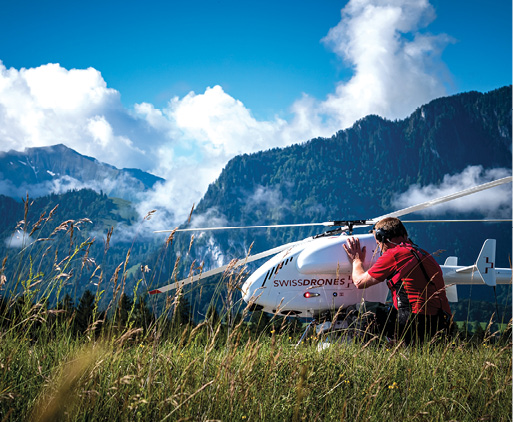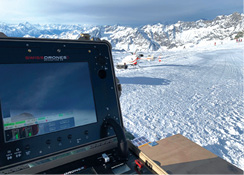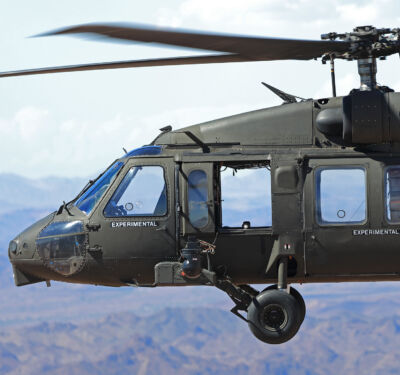
When conducting intelligence, surveillance and reconnaissance (ISR) missions via drone, payload capacity, stability and endurance are critical—and all are areas the SwissDrones team focused on when developing the SDO 50 V2 unmanned helicopter.
From border patrol to maritime surveillance, the system takes on a variety of ISR applications, quickly providing situational awareness and allowing decision-makers to track objects in real time. The UAS boasts a system-to-payload weight ratio of nearly one to one, made possible by its proprietary design.
Based on the Flettner principles of intermeshing double rotor systems, the UAS has two rotors in the front and no tail rotor, Head of Sales Luca Santini explained. Stability is built into the design, which is typically found in manned aircraft like the Kaman K-MAX that lift heavy cargo.
“The main advantage of our platform is payload capacity,” Head of Flight Operations Arangan Varatharajah said. “We have a payload capacity of about 45 kilograms, so you can carry a higher-quality payload and still get two to three hours of flight time.”
THE PAYLOADS
The SDO 50 V2 is payload-agnostic, Santini said, providing flexibility. Payloads may include multiple sensors, depending on mission requirements.
“Most of our clients focus on police missions, border patrol or firefighting missions so typically they’ll fly a gimbal stabilized camera,” Santini said. “Firefighters might use additional sensors that have the ability to automatically recognize a hot spot, see through smoke or detect change.”
SDO 50 V2 unmanned helicopters are also deployed by national search and rescue (SAR) agencies for SAR applications, with many using additional “search sensors,” he added.

THE BENEFITS
Beyond stability, payload capacity and endurance, the UAS comes with other features that lend themselves to ISR. One is durability; the unmanned helicopter is designed to operate in harsh conditions, including snow, ice, rain, heat, strong winds and high altitudes. It also refuels quickly, limiting downtime.
The UAS can fly at night, something that can be dangerous for manned aircraft in tight spaces or bad weather. And no matter when it flies, the stable platform can collect vibration-free video as it hovers. Unlike with a fixed-wing system, there’s no need to continuously rotate and point the gimbal at the point of interest.
The system’s 40-kilometer range can be extended via its 4G LTE backup in areas with 4G coverage, Santini said. A data link enables users to access video footage in real time, say at police headquarters, to make quick decisions.
The system’s quiet, vibration-free turbine engine also works well for ISR missions, Santini said. The team expects to release a new rotary engine by the end of the year, which will further increase flight time.
“This new type of engine rotary will help us double the time in the air to five to seven hours, depending on the payload,” Santini said. “It will also substantially increase the time between overhaul, which reduces the operating cost of the platform.






